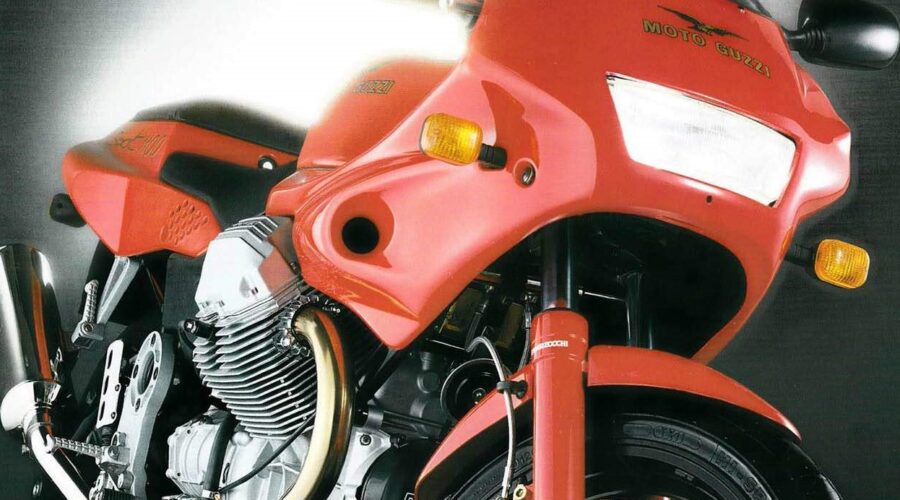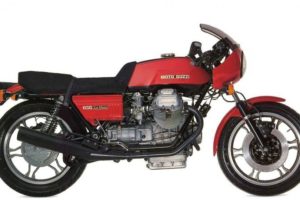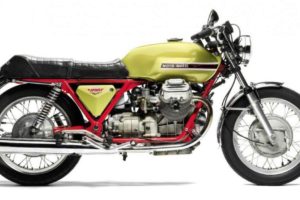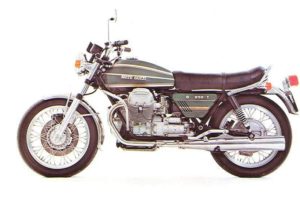1995 Moto Guzzi Sport 1100
I have discovered that the longer you are with the same partner, the better the sex becomes. It’s true, and the rest are just doing it wrong.
I was going to say the longer you are married, the better the sex becomes, but it wasn’t politically correct so I changed it. The rest of the story is totally politically incorrect but I don’t care. Red Italian motorcycles bring out the worst in me and I start slavering at the mouth and panting.
You see, I have this problem. Here I am trying to be as non-sexist and antidiscriminatory as I can and everyone I speak to describes this motorcycle in terms of women. And sex.
My problem is that I can see why. And, from looking at the pictures, no doubt you can too. Guzzi’s new Sport 1100 is impossibly lovely. It just looks so good that superlatives become superfluous. You just look at it and you know. You don’t have to say anything. You look at the guy standing next to you and you just know that he knows. And you smile that smile and he does the same thing and you don’t need to say anything else.

Looking at the Sport is like watching an attractive woman walking by. You don’t need to say anything, you can just appreciate the event and share it wordlessly.
I don’t know what it is about Italian bikes, why they tug at my heart like they do. Perhaps it is the audacious combination of brutality, alloy and redness. Perhaps it isn’t. They just affect me. It is a visceral thing. I like them with my stomach, not with my head. That comes later. I can think of a thousand reasons why Italian bikes are impractical, but once my stomach has made up its mind I can’t think of any reason why I wouldn’t buy one.
Often Italian motorcycles look so good that you imagine all of Italy’s creative genius went into the appearance, leaving precious little over for the actual workings of the actual bike. Too often this has been the case, and roadtesters have complained at meaningless details like carburation, electrical wiring looms, footboards, keys and locks, gearshifts, sidestands and heavy controls.
“So what?” I say.

My first encounter with the Sport was when I opened the seat with the same key which operates the ignition, fuel cap and helmet lock. The seat opened to reveal two batteries wired together — to save height — a tool kit and easy access to fuses, flasher unit, rear brake master cylinder reservoir. Then it closed again with barely finger pressure.
That last paragraph will be more than enough to alert the Italian Motorcyclists among you to the fact that this is a very different Italian motorcycle. They will now be writing cheques. The rest of you can read on.
Ignoring the choke and giving the throttle a couple of tweaks before thumbing the starter resulted in a minor explosion as the engine burst into life. Blipping the throttle as I waited for the warming, life-giving oil to course through the aortas and ventricles of the Sport’s heart made the bike rock from side to side in time-honoured fashion. The Sport felt at once like a real bike. Like a Guzzi.
As I sat there warming the bike up it was impossible not to caress the seductive curvature of the fairing and tank, impossible to stop my hand running down across the pulsating engine and impossible to ignore the fantasies which were intruding into my consciousness. The only recourse was to action.
And the best place for action was Eastern Creek. The mission was threefold: to add running in kilometres to the machine, to make those niggling little adjustments which always need looking at, and to get some nice, clean, early morning light photographs.
Oh, I wanted to have some fun, too.

The surprising thing about the bike at the track was how well it responded to the environment. Guzzis are not traditionally renowned for short circuit racing, their riders usually preferring to cover insane distances at insane speeds on the open road.
The Sport lapped up Eastern Creek, despite being limited to 6000 rpm. There is more than enough midrange to fry the tyres and provide an exciting morning’s entertainment. But it was the steering which was the delight. It managed to combine traditional straightline stability with an accuracy which is more often ascribed to Superbikes.
There is no discernible shaft reaction, the Dr John parallelogram rear end damping all of that out and the White Power shock damping out everything else but feel. In the photo shoot, repeated abuse on a right-hander caused the tyres to heat up and begin to wander, but I could at all times feel what was going on.
The front end is even better. I couldn’t fault it. The left-hand fork has a compression damping adjustment on top and the right has rebound damping knob. Adjustment on the move is simple and effective. Once I had upped the rebound damping one notch — to four from six — there was no front end instability at all. No hint of it.
And then there’s the brakes. A remote reservoir master cylinder linked to four-spot Brembos and 320 mm discs (up by 20 mm from the Daytona) by a pair of braided steel lines provided enough feel and control for me to get the rear axle up past hip height almost every stop in the photo shoot. And there was no discernible fade after repeated hard stops. Or should I say hard stoppies?
But with a machine like this, the track is the wrong environment. This is a road bike in the manner of the Seventies, when all the hard chargers rode Guzzis and bevel-drive Ducatis — or wanted to.

Scything through the curves which are inscribed into the hillside on the way up from the Coxs River to New Forest on the Jenolan Caves Road, the Sport was in its element. Stringing a series of 65 km/h corners together at a speed in excess of the advisory signs was a pleasure that will live with me until death us do part. The feeling of clipping an apex in a left-hander well cranked over and my body at the same time climbing out of the corner across to the other side of the machine in readiness for the following right as the bike completed the left before pressure on the pegs snapped it into full lean the other way verged on ecstasy.
This is a machine you caress into submission, a machine you commit your body to as you both strive together to the climax of the ride.
Or later, in the high-speed sweepers below the ridgeline as the road follows the roller coaster of the Blue Mountains hinterland, with my helmet nestled into the side of the screen, one knee covering the rocker cover and my other just inside my elbow as I rolled on the throttle and the torque curve built relentlessly until the power took over with a rush to red line and I snicked the next ratio while still cranking through the bend.
It is a road like this, and a bike like this and a morning like this which make the life of a motorcyclist so rich.
For me the Sport represents the logical development of the bevel-drive Ducati. When Bologna went for belt drive and water-cooling and fuel injection in the search for power and civility, the machinery lost the gut-wrenching appeal of the bevels. Moto Guzzi perhaps went one step to far in the same direction with the Daytona. For although the Sport and the Daytona appear similar, there is not one body panel which is the same. And I think the Sport looks leaner, meaner, better.
Hark back to the Seventies, to bikes like the Laverda SFC750, the Ducati 750 and 900 SSs and the Guzzi Mk1 Le Mans. They were strikingly beautiful machines which employed fairings to complement the rest of the machine and to highlight the engine. These days, fairings are used to hide unsightly things like batteries, coolant reservoirs and ugly — though incredibly efficient – water-cooled engines.
Not so the Sport 1100. Its fairing flows back from the aggressive leading edge to peel back over the exposed cylinder heads, allowing that mass of air-cooled, heavily- finned alloy catch the golden evening sun as you sit, looking out from the pub veranda after a long day’s ride.
It is verging on the pointless trying to describe the machine in words. It goes far deeper than that. And even a brief test ride is not going to do any good. Many riders just are not the right sort of person to own one of these machines. Many riders lack the passion, the personality and the faith to immerse themselves in the experience, to live with the machine rather than merely to own it.

Faults are merely foibles, problems are merely solutions yet to be found. I know the sidestand is miserable, but it can be fixed. I know that carburation below 2300 is miserable but that can be avoided. I know the gearbox action is heavy compared with Japanese bikes; I got used to it. I know that the pillion accommodation is spartan, but who carries a pillion on one of these? All of these things are either easily remedied or are things which are between the bike and its owner. Most relationships are built around a love and a respect which grows over time. The strongest are those which develop because of imperfections, rather than despite them.
The riders who understand this know instinctively that a machine is not a motorcycle, your motorcycle, until enough miles have passed between the two of you for a mutual trust and respect to have developed.
Each time I rode the Sport I rode it harder and I rode it better. And each time I rode the Sport it became a better motorcycle. It bedded in to me and I bedded in to it. It is not a motorcycle for a quick fling, a oneride stand. No, the Guzzi is a machine which demands a commitment, and a machine which repays a commitment with an emotional high. One onlooker remarked “You look at the blonde-haired, blue-eyed girl, but you fall into the eyes of the dark, alluring Spanish lovely, even though you know at times it is bound to be fiery.”
The Sport 1100 is all of these things. It is also a bloody good sportsbike.
The only other machine to test me like this was the 500 Gilera Saturno, a 500-cc pocket rocket which epitomised the equation of less power + less weight = more fun. I ordered one. It didn’t pass ADR compliance. Had it done so, I would own one now.
The Sport is another such motorcycle. Its equation is power + chassis = ecstasy. Would I own one?
Well, that is between me and my bank manager. And my longtime sexual partner.
By Jeremy Bowdler, Two Wheels, January 1995.

Falloon: The Classic View
By 1993 the Moto Guzzi 1000cc Le Mans V was truly obsolete but still had a loyal following that was for some reason eschewing the Daytona. To recapture that market Moto Guzzi released the Sport 1100.
This was a clever combination of the two-valve engine in a Daytona chassis, the origins being in the successful Dr. John Pro-Twins racer of 1987. As the styling too was more successful than the Daytona, and the performance similar, the simpler and cheaper 1100 Sport was an instant success.
There was considerably more to the Sport 1100 than simply taking a Daytona chassis and installing a tuned California 1100 engine. With Wittner’s help the 92x80mm 1064cc engine was uprated considerably with new 10.5:1 forged pistons, a lighter crankshaft, and camshafts developed by Crane in Florida. These were quite similar in timing to the mild cam of the earlier 850 Le Mans but featured much higher valve lift of 7.57mm (inlet and exhaust). The valve timing was inlet opening 22° before top dead centre, closing 54° after bottom dead centre, with the exhaust opening 52° before bottom dead centre, closing 24° after top dead centre. Valves too were reduced slightly from the Le Mans V to 46.5mm inlet and 39.5mm exhaust to allow for the increased valve lift. The squish band was also altered to improve combustion efficiency.

The flywheel was even lighter than the Daytona and the Dell’Orto PHM40 carburettors force-fed by a pressurised airbox. To overcome the problem of the excessively strong throttle springs of the earlier Le Mans V the throttle action was slowed down. This was successful but still not entirely satisfactory. Ignition was by Marelli-Digiplex and power a muscular 90 horsepower at 7,800rpm. The straight-cut gearbox and 10 spring clutch were shared with the Daytona.

While the frame too was similar to the Daytona, there were some significant alterations for the 1100 Sport. The front frame downtubes were welded, not bolted, and the mounts under the gearbox were steel rather than aluminium. The driveshaft assembly was redesigned to include grease nipples at each U-joint, plus one at the sliding spline connection. Also to help reduce U-joint wear a shorter (White Power) shock absorber was used and a longer rear drive torque-arm.
Front suspension was 41.7mm Marzocchi, the fork legs initially painted to match bodywork. From 1995 the fork legs were painted silver. Braking was uprated over the Daytona with 320mm front discs, with a 260mm floating rear disc, although this was no longer located with a brake torque-arm. The rear wheels remained at 17 inch front and 18 inch rear, still without a cush drive.

With a restyled dual seat and fairing the Sport 1100 was immediately seen as better value than the Daytona. Performance too was comparable, “Cycle World,” in December 1995 achieving a standing start quarter mile in 11.91 seconds at 114.71 mph (184 km/h). “Motociclismo” found the 220.4 kg 1100 Sport not quite as fast as the Daytona, with a top speed of 218 km/h (135 mph).
As with the Daytona, there was a different fairing and larger rectangular headlight for the U.S., Britain, Australia and Japan. Production immediately eclipsed the Daytona with 365 constructed from September 1994 and a further 1,191 during 1995. A final 215 carburettor 1100 Sports were manufactured in 1996 before it was replaced by the 1100 Sport Injection.

Alongside the announcement of the Daytona RS in April 1996 was a Sport 1100 replacement, the 1100 Sport Injection. This took the Sport 1100 engine (same camshaft but with 9.5:1 pistons) with many of the features of the Daytona RS. These included the crankshaft with 45.5mm crankpin (without the Carrillo con-rods), external oil cooler, and revised oil filter arrangement. There was also yet another flywheel and oil temperature transducer. As with the Daytona RS, early examples used the straight-cut Sport 1100 gearbox, but later versions (from CF 011500) featured helical gears. The Weber-Marelli injection system was the same as the Daytona RS with a 16 Megabyte CPU but different (IW031) injectors and 45mm throttle bodies.

The frame and running gear was shared with the Daytona RS, the only differences being stainless-steel 320mm front brake discs and a higher profile 160/70ZR17 inch Pirelli Dragon rear tyre. Thus the 1100 Sport IE was significantly improved in most areas over the preceding Sport 1100. Although it was still a heavy motorcycle, many comparison tests with Ducati’s 900 Supersport saw the 1100 Sport IE on top. Performance too was up on the carburettor Sport 1100. “Motociclismo”, in September 1996 achieved a top speed of 223.3 km/h (139 mph) from their 227.2 kg test bike.
Unfortunately, while the 1100 Sport IE was undoubtedly the finest of Moto Guzzi’s sporting two-valve machines, it also came too late. Although more popular than the Daytona RS, it was discontinued during 1997. A final 200 1100 Sports were released in March 1998 as the 1100 Sport Corsa Limited Edition. Featuring Carrillo con-rods and a black engine and wheels, these also came with a Termignoni carbon-fibre exhaust kit. Immediately this final series was seized upon by collectors as the epitome of the 1100 Sport.
Ian Falloon is one of the world’s foremost authorities on classic motorcycles and a prolific author. His Moto Guzzi titles include The Moto Guzzi Sport and Le Mans Bible, The Essential Buyer’s Guide to Moto Guzzi Two Valve Big Twins, The Moto Guzzi Story and The Complete Book of Moto Guzzi. You can order copies from Veloce Publishing here.





